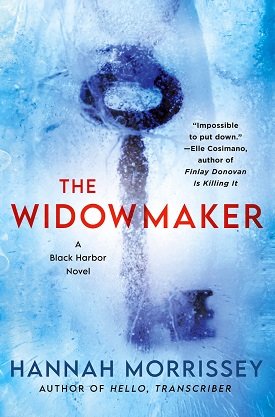I’m absolutely thrilled to share a fantastic Q&A with Jane Robins today, whose psychological thriller WHITE BODIES (Touchstone; on sale 9/19/17) was exactly my cup of tea. You know that wonderful feeling when you pick up a book and realize it’s somehow just exactly what your reading list has been missing? That’s how WHITE BODIES was for me. Quirky, offbeat, and genuinely twisted, this psychological thriller delivers an original and exciting read—it’s a breath of fresh air in the crime fiction genre. If you’d like to sample this book for yourself, make sure to check out the excerpt I previously ran of WHITE BODIES - you can read that here!
I was delighted to have the chance to ask a few questions of Jane, and learn more about this brilliant read! In this Q&A, Jane covers everything from the inspiration for her wonderfully weird protagonist, Callie, to the comparisons drawn between WHITE BODIES and Strangers on a Train, and much, much more.
Many thanks to Jane for answering my questions so thoughtfully, and to her publisher for facilitating this Q&A!
WHITE BODIES - PLOT SUMMARY:
This chilling psychological suspense novel—think Strangers on a Train for the modern age—explores the dark side of love and the unbreakable ties that bind two sisters together.
Felix and Tilda seem like the perfect couple: young and in love, a financier and a beautiful up-and-coming starlet. But behind their flawless façade, not everything is as it seems.
Callie, Tilda’s unassuming twin, has watched her sister visibly shrink under Felix’s domineering love. She has looked on silently as Tilda stopped working, nearly stopped eating, and turned into a neat freak, with mugs wrapped in Saran Wrap and suspicious syringes hidden in the bathroom trash. She knows about Felix’s uncontrollable rages, and has seen the bruises on the white skin of her sister’s arms.
Worried about the psychological hold that Felix seems to have over Tilda, Callie joins an Internet support group for victims of abuse and their friends. However, things spiral out of control and she starts to doubt her own judgment when one of her new acquaintances is killed by an abusive man. And then suddenly Felix dies—or was he murdered?
A page-turning work of suspense that announces a stunning new voice in fiction, White Bodies will change the way you think about obsession, love, and the violence we inflict on one another—and ourselves.
Q&A: Jane Robins
Crime by the Book: First things first: what inspired you to write WHITE BODIES?
Jane Robins: I had written three narrative non-fiction books, and felt ready for a new challenge. I didn’t know whether I’d be able to write fiction, and thought that for a first novel I should stay with the form that I know best, which is crime. Two of my non-fiction works are historical true crime—and while I was writing them I tried, through extensive research, to get under the skin of both the perpetrators and the victims of crime (namely murder), and to understand their relationships with their social environment. I loved writing from this perspective, and knew I wanted to write a novel that was both character and plot driven. Hence, the psychological thriller which became White Bodies.
CBTB: If you could describe WHITE BODIES in 3 adjectives, which would you choose?
JR: Intense. Eccentric. Twisty.
CBTB: WHITE BODIES is being described as (and I agree!) a modern-day Strangers on a Train. Was Highsmith’s book an intentional source of inspiration for your psychological thriller?
JR: Yes it was. When I was thinking of writing a crime novel I watched the classic film of Strangers on a Train with my teenage son, and I thought, “oooo..!” I could do something with this idea. It was a starting point for me—and then I got sucked in, and developed my own twists on the concept of trading murders. I liked having the film make an appearance in White Bodies—it was a way of saying thank you to Highsmith and Hitchcock!
CBTB: My personal favorite element of this story is the quirky, sometimes truly strange main character of Callie. She’s completely absorbing to read about—I found myself wholly immersed in her (sometimes bizarre, but in the best way!) worldview. Where did you first come up with the idea for this character?
JR: It’s actually quite hard to remember how I came up with Callie’s character. I knew that I wanted a fairly socially naïve young woman who was observing another more accomplished woman, with a sense of wonder tinged with a self-perception of inadequacy. Also, I wanted the narrator to be a true, thoughtful observer. I think I was influenced by various novels including Daphne Du Maurier’s Rebecca. Also I’m a massive fan of a short novel by Josephine Hart called Sin about two sisters. In fact, I regard it as a modern classic. This is a quote from it:
“Though she wounded me beyond pain, I too inflicted deep hurt. Not born to murder her, still I sought to break her . . . Her name was Elizabeth Ashbridge. And I even envied her that.”
Then, as I started to write Callie, she became a real person to me. I felt that I was “getting to know her” as much as creating her.
CBTB: WHITE BODIES could in many ways be considered a domestic thriller—it features a potentially-abusive husband and wife relationship. But in this book, your focus is instead directed towards the story’s central familial relationship—that is, the relationship between twin sisters Callie and Tilda. Why focus on these two women? Why not make the focal point of the story Tilda’s relationship with her husband, Felix?
JR: It just felt more original to me—with a lot of potential to get seriously twisted. And I liked the idea of creating twins with such different characters, who are opposing sides of a single coin.
CBTB: Without spoiling anything, readers will discover that one of the characters in this book has an odd (and sometimes genuinely repulsive) habit: he or she eats things that belong to others, in an attempt to feel close to them. Is this an entirely fictional disorder, or does this really exist?
JR: I didn’t google this condition—I just made it up! It made psychological sense to me that Callie would try to “own” someone else by eating her things. Many years ago, I made a weird joke to a boyfriend of mine—I told him that I was a witch, and if I ate his hair he would never be able to leave me. I think the idea for Callie’s behaviour came from that. (I didn’t eat his hair, and he did leave… maybe because I was so creepy!)
CBTB: Similarly, without spoiling anything, WHITE BODIES includes a couple genuinely shocking reveals and twists! It’s been a long time since the ultimate reveal of a psychological thriller surprised me as much as this one did. When you set out to write this book, did you always know how it would end? Or did this ending develop over time?
JR: I definitely planned an ending before I started writing… but then I changed it. Of course, I can’t say how! Just to say—it got darker.
CBTB: When you’re not writing crime fiction, do you also read crime fiction? If so, I’d love if you would share a few recent crime novels you’ve read and enjoyed!
JR: Yes, I read crime fiction all the time. I loved Sophie Hannah’s latest, which is called Did you See Melody? in the UK, and will be released on September 19 in the US as Keep Her Safe. I recently read a crime classic—Joy Fielding’s See Jane Run, which is brilliantly written. It’s not well-known in the UK, and is out of print. I think it deserves a revival. And thought there was a Highsmith vibe going on in Sabine Durrant’s excellent Lie With Me.
CBTB: What are you working on next? Can we expect another psychological thriller from you?
JR: Yes, it’s another psychological thriller. This time I’m writing in the first person in a male voice, which is a wonderful challenge. The new novel is about a group of young people attending a play-writing Summer School in a remote part of England—and then the deaths start!
It has a slow, intense build, exploring psychological themes and making the reader wonder about the trustworthiness of some of the characters. My narrator John is far more erudite than Callie—but more “damaged.” As in White Bodies, I have American characters. In the new book, it is the Americans who are rather unknowable and glamorous—and I’m doing my best to channel a little of a Henry James vibe into the story. Also, the final part of the novel will move to Boston and Martha’s Vineyard. I don’t have a title yet.
Book Details:
Read CBTB’s Review of WHITE BODIES
Read an Excerpt of WHITE BODIES
Hardcover: 304 pages
Publisher: Touchstone (September 19, 2017)
ISBN-13: 978-1501165085
Crime by the Book is a participant in the Amazon Services LLC Associates Program, an affiliate advertising program designed to provide a means for sites to earn advertising fees by advertising and linking to Amazon.com. This in no way affects my opinion of the above book.














Home ownership feel like a distant dream? Zillow listings have you convinced you’ll be renting for the rest of your life? The woman at the heart of Carissa Orlando’s debut The September House feels your pain—and she’s prepared to put up with a lot if it means she and her husband can finally have a place to call their own. In this case, that might just mean living in a house that’s haunted. Playful and irreverent, spine-tingling and spooky, The September House puts a fresh spin on the classic haunted house story, delivering an immersive tale about the secrets lurking within one building’s walls, and within the lives of its inhabitants.